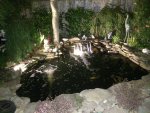bettasngoldfish
Maria
Not quite sure how this will work as I'm on my iPhone.
I've been koi ponding 23 years and have to say, water changes are a necessity. Some do 10% a week, others like myself do 20% every 10 to 2 weeks depending. Perfect looking water can be toxic so one can't go by looks.
Testing is paramount. I test mostly for ammonia, PH , nitrite, and one of the most important KH. With low or no KH, you're apt to have a PH crash. The PH # isn't as important { mine is always 8.4 } as is the stability. A crash is a killer.
I also do potassium permanganate treatments monthly keeping bacteria down to a minimum. It isn't suggested for beginners but with much reading, you'll have no problem. It also keeps down on water changes a bit if it is cleared with hydrogen peroxide. The water looks like glass afterwards for quite some time.
I suggest getting books and keep reading. With proper filtration and water chemistry, there is no reason to be adding these so called beneficial bacteria's on the market and all other crazy chemicals sold.
Of course if there is a problem and you isolate it with possibly a microscope or by eye, you'll need to treat it but for most part, water chemistry is the key.
There is bacteria I've used when enlarging my pond or for new ponds that seed the ponds bacteria in 5 days. It's called Turbo 700 by Fritzyme. It had to be sent overnight packed in ice and can be refrigerated up to 3 months. It contains nitrosoma and bactrosoma which are the bacteria that thrive on ammonia and nitrites.
Well, just thought I'd share this as an FYI.
Ciao
Not sure where this will land as first time posting.
Welcome to the group, nice to have you
Why not post in the Introductions section and tell us a little about yourself. I would love to see pictures of your koi.




